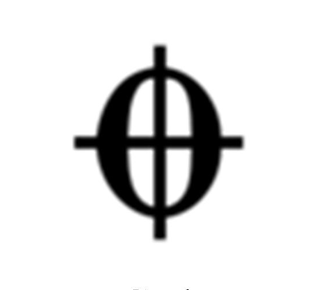
HOSTS- Jeremy Burns, Matthew Scott Phillips
TYPE- Special Topics
DURATION- 99:18
BUMPER MUSIC- "We Can Pull This Off" (Area 47)
ANNOUNCER- Mike Cunliffe
Resuming from the previous episode, it's time to top off our discussion on reading music. We're going to take it back to the basics with the clefs, the lines and spaces of the staves, the notes they represent and some methods for grouping them. We'll also cover the notes and rests, their symbols and the time values they represent. Finally, we'll cover some dynamics, tempo and form indicators that we may have missed in past episodes!
CLEF- A symbol that tells the performer what range of notes to play within. This symbol often focuses on the line of the note it is named after.
DYNAMICS MARKINGS- Symbols on a music score that tell the musician how loud or soft to play. Dynamics are concerned with expression and can greatly influence the emotional impact of a passage of music.
PERFORMANCE MARKINGS- Symbols on a music score that tell the musician how to execute a note or group of notes.
TEMPO MARKINGS- Symbols on a music score that tell the musician how fast or slow to play. Tempo markings preceded the invention of the metronome and the current system of BPM's (beats per minute), which can more accurately dictate which tempo to play.
KEY SIGNATURE- Located to the right of the clef symbol, this tells the performer which notes to raise (with sharps) or which notes to lower (with flats).
METER SIGNATURE (TIME SIGNATURE)- A number representing the grouping of beat that comprise the meter.
RHYTHM- Very closely tied to pulse, a regular repeated pattern of sounds that move music forward.
NOTE- A symbol used to signify the duration and pitch of a tone.
DOTTED NOTE- Lasts for the duration of the note plus half the duration of the that note.
METER- Grouping of beats into equal parts,based on stressed and unstressed beats.
MEASURE- One repetition of a pattern of stressed and unstressed beats.
DUPLE METER- A meter with one stressed beat and one unstressed beat.
TRIPLE METER- A meter with one stressed beat and two unstressed beats.
SIMPLE METER- When the pulses can be divided into 2's.
COMPOUND METER- When the pulses can be divided into 3's.
THE G CLEF (TREBLE CLEF)

The G CLEF (TREBLE CLEF), seen here on a single staff, puts the MIDDLE C note on the lower ledger line, resulting in the notes E, G, B, D and F on the lines and F, A, C and E on the spaces. Notice how the inner spiral of this symbol circles the line that the G note has been assigned to.
THE F CLEF (BASS CLEF)
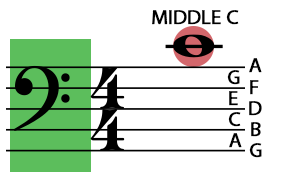
The F CLEF puts the
MIDDLE C note on the upper ledger line, resulting in the notes G, B, D, F and A on the lines and A, C, E and G on the spaces. Notice how the two dots and the spiral of this symbol focus the eyes on the line that the F note has been assigned to.
THE C CLEF (ALTO CLEF)
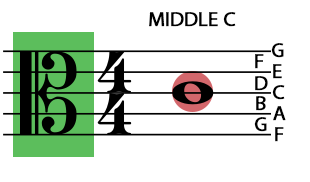
The C CLEF puts the
MIDDLE C note on the 3rd line, resulting in the notes F, A, C, E and G on the lines and G, B, D and F on the spaces. Notice that the middle C will always be placed where this symbol is divided, horizontally.
VARIATIONS OF THE C CLEF
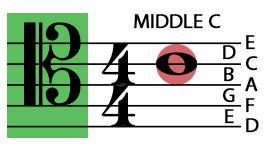
The TENOR CLEF puts the
MIDDLE C note on the 4th line, resulting in the notes D, F, A, C and E on the lines and E, G, B and D on the spaces. Again, notice that the middle C was placed where this symbol is divided, horizontally.
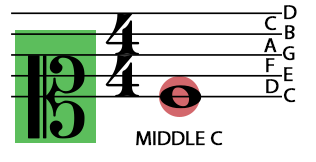
The SOPRANO CLEF puts the
MIDDLE C note on the 1st line, resulting in the notes C, E, G, B and D on the lines and D, F, A and C on the spaces.
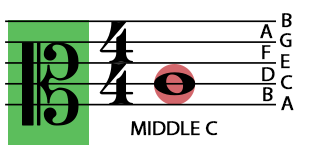
The MEZZO-SOPRANO CLEF puts the MIDDLE C note on the 2nd line, resulting in the notes A, C, E, G and B on the lines and B, D, F and A on the spaces.
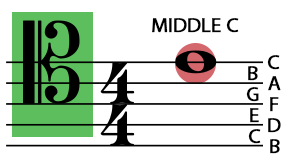
The BARITONE CLEF puts the MIDDLE C note on the 5th line, resulting in the notes B, D, F, A and C on the lines and C, E, G and B on the spaces.
KEY SIGNATURE
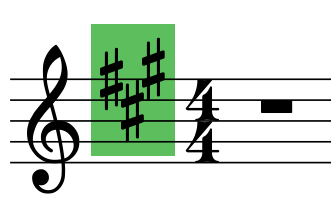
The KEY SIGNATURE indicates which notes to sharpen or flatten. In this case, we will sharpen the notes F, C and G. This results in the key of A major OR F# minor. The content of the music and harmonic progressions will likely inform us which of these two keys is the most likely.
TIME SIGNATURE (METER SIGNATURE)
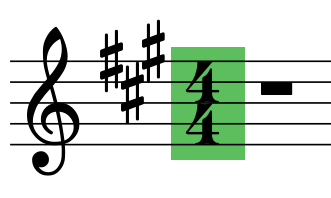
The TIME SIGNATURE indicates the number of beats per measure (on the top) and the note value (on the bottom). In this case, we are playing in 4/4 (a.k.a. common time). So there will be 4 quarter notes per measure.
WHOLE NOTE
WHOLE NOTE REST
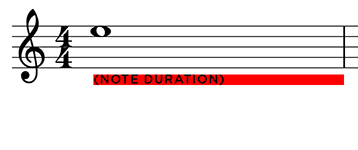
COUNT: 1 2 3 4
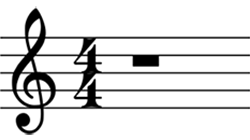
HALF NOTE
HALF NOTE REST
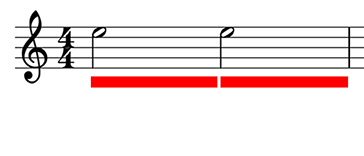
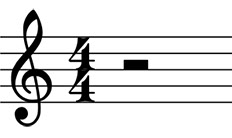
COUNT: 1 2 3 4
QUARTER NOTE
QUARTER NOTE REST

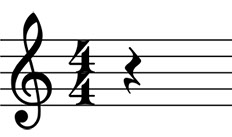
COUNT: 1 2 3 4
EIGHTH NOTE
EIGHTH NOTE REST
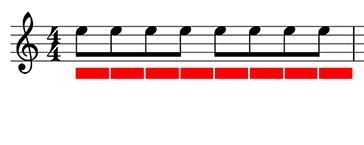
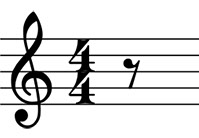
COUNT: 1 2 3 4
SIXTEENTH NOTE
SIXTEENTH NOTE REST
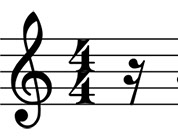
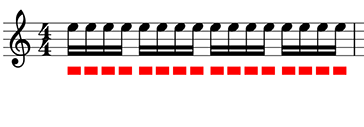
COUNT: 1 e + a 2 e + a 3 e + a 4 e + a
After the first flag is added to the eighth note, each time we divide the note we add a flag. So 2 flags for sixteenth notes, 3 flags for thirty second notes, 4 flags for sixty forth notes, etc.
TRIPLET
Below we have an example of snare drum music. Notice that, in both measures, beats 1, 2 and 4 are straight quarter notes. On beat 3, three eighth notes occupy the space of one quarter note ( a space normally occupied by 2 eighth notes).

DOTTED QUARTER NOTE
DOTTED HALF NOTE
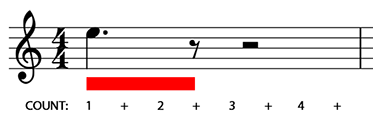
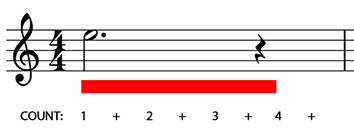
Similar in appearance to the SLUR, TIES are meant to connect two notes of the same pitch, often from one measure to the next.
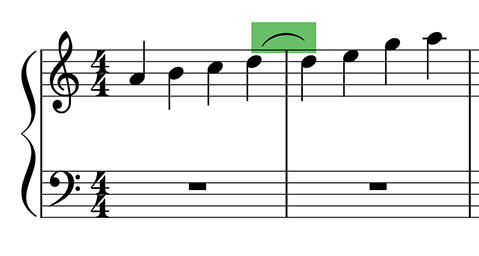
The notes within the SLUR are supposed to be played without separation. So in the below example, all of the notes from A to A would be played within one breath or bow stroke.
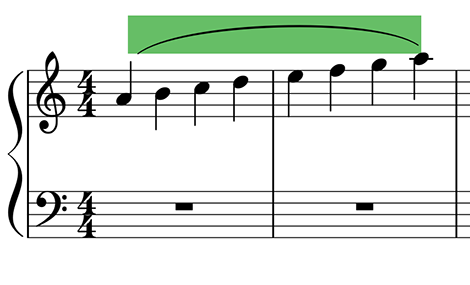
TEMPO MARKINGS
THERE ARE MANY DIFFERENT TERMS USED TO CONVEY TEMPOS. THE BELOW LIST WILL INCLUDE SOME OF THE MORE COMMON TERMS ALONG WITH THEIR SUGGESTED BPM's (BEATS PER MINUTE). YOU WILL NOTICE SOME OVERLAP.
LARGHISSIMO – Very, very slow (24 bpm or less)
GRAVE – Very slow (25–45 bpm)
LARGO – Broadly (40–60 bpm)
LENTO – Slowly (45–60 bpm)
LARGHETTO – Rather broadly (60–66 bpm)
ADAGIO – Slowly, "at ease" (66–76 bpm)
Adagietto – Slower than andante (72–76 bpm)
Andante – Walking pace (76–108 bpm)
Andantino – A little bit walking pace (80–108 bpm)
Marcia moderato – Moderate, marching (83–85 bpm)
Andante moderato – Between andante and moderato (92–112 bpm)
Moderato – Walking with purpose (108–120 bpm)
Allegretto – A little allegro (112–120 bpm)
Allegro – Jogging (120–168 bpm)
Vivacissimo – Running (172–176 bpm)
Allegro vivace – Running very fast (172–176 bpm)
Presto – Sprinting (168–200 bpm)
Prestissimo – Running for your life (200 bpm and over)
Below, we have the A section of "Milano" by John Lewis
(courtesy of "The Real Book").
We can see by the DOUBLE BARS AND DOUBLE DOTS that this section was meant to be repeated. On the first go through, measures 1-7 will play through and all the way through measure 8. On the 2nd go through, we again play through measures 1-7. But we skip over measure 8 and go directly to measure 9 to finish off the section.
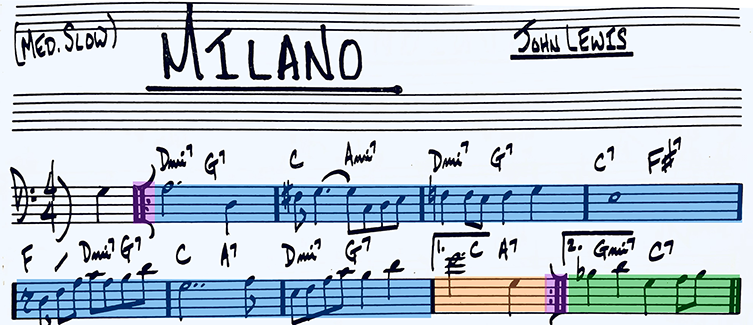
DA CAPO
DA CAPO translates to "from the head" or "from the top". When we see the symbol below, we know to back to the begining of the piece.
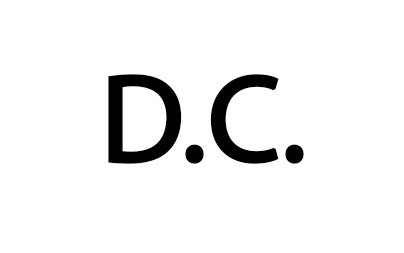
DAL SIGNO
If a measure ends with the words "DAL SIGNO" over it, we jump to where ever we see the sign below.
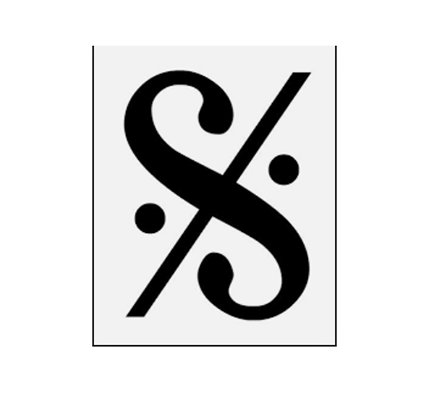
CODA
CODA will be an ending passage that we will be directed to when we see the symbol below.
